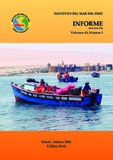Por favor, use este identificador para citar o enlazar este ítem:
https://hdl.handle.net/20.500.12958/3065| Título : | Biomasa y distribución del calamar gigante (Dosidicus gigas) en el mar peruano aplicando el método hidroacústico: 1999 - verano 2015. |
| Otros títulos : | Biomass and distribution giant squid (Dosidicus gigas) in the Peruvian sea applying the hydroacoustic method: 1999 - Summer 2015 |
| Autor : | Flores Huamán, Oswaldo Segura Zamudio, Marceliano Aliaga Rosales, Aníbal |
| Palabras clave : | Calamar Gigante;Dosidicus Gigas;Método Hidroacústico;Pota |
| Fecha de publicación : | 2016 |
| Editorial : | Callao |
| Citación : | Inf Inst Mar Perú 43(1), 2016. p. 5-10 |
| Citación : | Informe IMARPE;Vol. 43, N° 1, 2016 |
| Resumen : | La biomasa y distribución espacial del calamar gigante o pota (Dosidicus gigas) estimada mediante el método hidroacústico fue variable entre 1999 y 2015. La biomasa promedio en las estaciones de verano fluctuó entre 500.000 y 800.000 toneladas (t) a excepción del 2004 y 2005 cuando se estimaron las mayores abundancias con 1,7 millones de t y 1,6 millones de t, respectivamente. Las menores abundancias en verano, correspondieron a los años 2000, 2013 y 2014 con alrededor de 100.000 t. Durante la primavera, las mayores abundancias se registraron en el 2001 (863.000 t) y 2002 (879.000 t). En invierno, las biomasas fluctuaron entre 4.000 t (2010) y 560.000 t (2001). La variabilidad de la distribución espacial de la pota estuvo asociada a parámetros oceanográficos, influenciada principalmente por el frente oceánico y las masas de Aguas Subtropicales Superficiales (ASS); así como a isotermas de 18 °C a 25 °C e isohalinas de 34,8 ups a 35,5 ups. ABSTRACT: Biomass and spatial distribution of giant squid or jumbo squid (Dosidicus gigas) was estimated using hydroacoustic method and shown variability between 1999 and 2015. The average biomass in the summer fluctuated between 500,000 and 800,000 tons (t), with the exception in 2004 and 2005 when the highest abundances were estimated in 1.7 million t and 1.6 million t, respectively. The lower abundances in summer, corresponded to the years 2000, 2013 and 2014 with around 100,000 t. During the spring, the highest abundances were recorded in 2001 (863 thousand tons) and 2002 (879 thousand tons). In winter, the biomass fluctuated between 4.000 t (2010) and 560,000 t (2001). The variability of the spatial distribution of jumbo squid was associated to oceanographic parameters, influenced mainly by the ocean front and Subtropical Surface Waters masses (SSW); beside with sea surface temperature between 18 °C to 25 °C and isohalines 34.8 ups to 35.5 ups. |
| Descripción : | Informe IMARPE 43(1), 2016 p. 5-10 |
| URI : | https://hdl.handle.net/20.500.12958/3065 |
| Aparece en las colecciones: | Informe vol. 43(1), 2016 |
Ficheros en este ítem:
| Fichero | Descripción | Tamaño | Formato | |
|---|---|---|---|---|
| Informe 43(1)-1.pdf | 2,18 MB | Adobe PDF |  Visualizar/Abrir |
Este ítem está sujeto a una licencia Creative Commons Licencia Creative Commons

